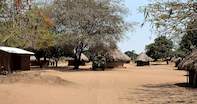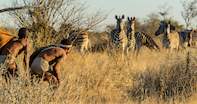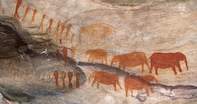
These are some of the top cultural experiences you can experience while on safari in Africa. Learn more about the tribes, cultures, and traditions of the local African people.
Feel the Rhythms of Soweto

Soweto throbs with life. Bright minibus taxis race around; passengers wait at the roadside and use finger symbols to tell the driver their destination; radios blare the latest in music. The township is slowly shaking off its apartheid past. The Hector Pietersen museum commemorates the 1976 student rebellion, while Winnie Mandela runs a controversial museum at the Mandelas' old home in Orlando.
Enterprise is everywhere, from houses advertising bridal services to hawkers selling goats and chickens. The Oppenheimer Park has splendid views over Soweto from a mock Zimbabwe tower. Shebeens (bar-restaurants) and homely B&Bs offer sustenance. Nowadays, Soweto's visitors are waved off with a heartfelt 'Hamba Kahle' (Zulu for 'go well') - Charlene Smith.
Spend the Night in a Local Village

My night at Zambia's Kawaza village took me far beyond the Africa of wildlife parks. As the sun went down, villagers gathered around the fire to sing and dance to an accompaniment of drums. After most had gone to bed, Jackson, the headman, and his wife, Mrs Headman, stayed by the fire with one of their grandsons.
Jackson brought out an old musical instrument made of a gourd and the couple sang some of their favourite songs. Then, with the small boy listening attentively at their feet, Jackson told a string of long stories. Each had a moral, wrapped up in humour. It was a touching sight; a rich human experience. - Guy Marks
Forage with Bushmen

Go walking with Bushmen in the Kalahari: their amazing bush skills surpass those of the most famous safari guides. They're born in the bush and grow up with it. It's their nursery and classroom; no wonder they know so much. I set off with Kgao and Nqeisi briskly walking ahead, a little apart, as they chatted in the melodious clicks of the Ju/'honasi language.
Berries were collected and eaten, and exploding seed heads found for entertainment, before Kgao spotted a small, green shoot at thirty paces. Minutes later he'd dug up a water-filled tuber the size of a basketball. Shortly Nqeisi found a spring hare's hole and eventually fished the unlucky creature out with a long, flexible pole. Occasionally I stopped to ask about plants, only to be told more than I could possibly remember. If you want to find Africa's best guides, look no further. - Chris Mcintyre.
Wonder at San Rock Art

Some of the images leap out at me - a hunter with bowstring drawn or a group of prancing zebra. But more often than not, the rock paintings are faint and elusive - a fading legacy of the San artists who created them up to 30,000 years ago.
These extraordinary images, daubed on boulders and rocky overhangs along the Sevilla Trail in South Africa's Cederberg Wilderness Area, are not the most famous examples from the continent's treasure-store of rock art. But more often than not, it is what you see beyond these paintings that counts for more than the designs themselves.
Along with their hunter-gatherer lifestyle, the southern San have long-vanished. Ironically, some of their last paintings depict sailing ships, people in Dutch costumes and men with rifles - innocent records of the 17th century European invasion that would seal their fate. - William Gray
Visit the Ruins of Great Zimbabwe

Great Zimbabwe, which supported some 20,000 souls in the years 1100-1500, is unequivocally the most impressive indigenous ruin in sub-equatorial Africa. The architectural highlight is the magnificent Great Enclosure.
Measuring some 250m in circumference and hemmed in by a 5m-thick granite wall, this intriguing structure (thought to have once housed the king's wives and mother) is dominated by a 10m-high conical tower. The latter is said variously to represent a phallus, a granary, a rainmaking shrine or none of these things. Although its contemporary name goes unrecorded, the city of Great Zimbabwe was of enormous significance as the ultimate source of the gold traded out of the Swahili port of Kilwa to ships from Arabia and Asia.
Architectural and historical importance notwithstanding, the most compelling thing about Great Zimbabwe is its abiding aura of mystery. You only have to wander around in the half-light of dusk, when the old stone ruins are free of tourists, and the impassive stones of the abandoned city can feel positively haunted. - Philip Briggs
Relive History on the Battlefields

'It was a misty evening - pitch black.' My guide, Gilbert Torlage, spoke with a quiet, earnest voice as we stalked the fog-bound slopes of Spioenkop in KwaZulu Natal. 'They were given strict orders - no smoking, no talking, no lights. Fix bayonets and move forward.' It was an ill-conceived plan.
When 1700 British troops drove a small Boer force from Spioenkop on the night of 23rd January 1900, they found themselves hopelessly exposed the following dawn. In silence, we roamed the summit of the hill, now studded with crosses and memorials. British mass graves lined the original trenches, while individual graves were scattered across the slopes where Boers fell. 'I must have recounted this battle 500 times,' Gilbert told me as we watched the last shreds of morning fog lift from the Tugela Valley far below. 'But it never fails to move me.' A month after the Battle of Spioenkop, the British severed the Boer line and broke the siege of Ladysmith.
But the war dragged on until the last Boer 'bitter-enders' surrendered in May 1902. More than 65,000 lives were lost. The prophecy of Boer General, Piet Joubert, had come true: 'This gold will cause our country to be soaked in blood.' - William Gray
Pony Trek in Lesotho
Pony trekking deep in the heart of Lesotho's Maluti Mountains instils emotions of pleasure, pain and freedom. These sensations arise from encountering nature and humanity at their most extreme - delighting at the infinite mountaintop beauty; hearing pitch-perfect voices of young herd boys soaring across the valleys, then anguishing at the cruel drought the Basotho people and their livestock have silently endured.
On a sure-footed pony, I enter a medieval world of mud hut villages where remote peasant communities have only what they need to survive. Our lifestyles may be a million miles apart (I declined to share the same sleeping quarters as a recently slaughtered cow), but their spontaneous smiles and purity of emotions never made me wish I was anywhere but on a pony amongst these people in the Kingdom of the Sky. - Carrie Hampton

 Go and Eat Mopane Worms - Carrie Hampton has been exploring Africa's weird and wonderful food again and this time it caterpillars. Read on f...
Go and Eat Mopane Worms - Carrie Hampton has been exploring Africa's weird and wonderful food again and this time it caterpillars. Read on f... Nothing quite captures the true spirit of East Africa, like a safari in Kenya's richest game sanctuary, the Masai Mara. It is here that the ...
Nothing quite captures the true spirit of East Africa, like a safari in Kenya's richest game sanctuary, the Masai Mara. It is here that the ...